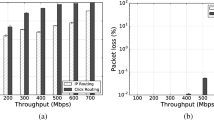Abstract
The virtual path (VP) can simplifyAtm network management by minimizing connection routing and admission costs, and by facilitating the layered control of resources. However, fully exploiting these advantages may lead to a large number of relatively low capacity virtual paths travelling on each physical link. If each VP is treated as a separate unit, as is commonly assumed, low path capacities will lead to low network utilisation. This paper carefully examines the trade-off between simplification through traffic separation and improved efficiency due to traffic consolidation. We review existing vp bandwidth assignment and control techniques, and propose a new vp tagging control method. A comparison shows that by permitting resource sharing between paths it is possible to influence significantly the trade-off between simplified network management and multiplexing gain from traffic consolidation.
Résumé
L’utilisation de conduits virtuels peut simplifier la planification d’un réseau en techniqueAtm, en réduisant les coûts d’admission ou de connexion et en facilitant la gestion en couches des ressources. L’exploitation sans réserve de ces possibilités peut cependant conduire à une structure de réseau comptant un grand nombre de conduits virtuels de capacité relativement faible routés sur de gros conduits physiques. Si chaque conduit virtuel compte alors comme unité indépendante — ce qui est usuel—la taille trop faible des conduits virtuels conduira à une mauvaise utilisation du réseau. Cet article cherche donc un compromis entre la simplification obtenue en scindant le trafic et l’amélioration des performances due à son regroupement. On passe en revue les techniques de contrôle de trafic et d’allocation de débit : puis, on propose une nouvelle méthode de marquage de conduits virtuels. La comparaison montre que le partage des ressources entre les différents conduits influe considérablement sur le compromis entre une gestion simple du réseau et le bénéfice qu’on attend du multiplexage d’appels.
Similar content being viewed by others
References
Addie (R. G.). Alternative bandwidth switching network architectures. TRL Spring Seminar, Future Networks for Service Flexibility. Session 3, Australia (1987).
Addie (R. G.), Burgin (I. L.), Sutherland (S. L.). ?-isdn protocol architecture. GWBECOM’88, Florida, Paper 22.6 (1988).
Anido (G.). Traffic control and management mechanism for a broadband packet network. ITC Specialist Seminar, Adelaide, Paper 12.1 (1989).
Atkinson (D. J.), Anido (G. J.), Bradlow (H. S.). Designing Atm virtual networks. 6th Aust. Teletraffic Research Seminar, Wollongong (1991), pp. 183-192.
Burgin (J. L.), O’Neill (C). ?-isdn resource management using virtual paths. 3rd Australian Teletraffic Research Seminar, Paper 11.2 (1988).
Burgin (J. L.). Resource management and control in the broadband integrated services digital network.PhD Thesis, Monash University, Australia (1990).
Burgin (J. L.), Dorman (D.). ?-isdn resource management : the role of virtual paths. IEEE Communic. Mag. (1991), 29, no 9.
***. Report of meeting on traffic control and resource management. CCITT Study Group XVIII, Temporary Document 36 XVIII/8, Geneva (1991).
Cavallero (E.), Mocci (U.), Scoglio (C.), Tonietti (A.). Optimization of virtual-path/virtual-circuit management in Atm networks. Networks 92, Kobe (1992), pp. 153–158.
Roberts (J. W.). Performance evaluation and design of multiservice networks. Final report. Commission of the European Communities Directoriate-General Telecommunications, Information Industries and Innovation. Ed. COST 224, Brussels, Luxemburg (1992).
Dutkiewicz (E.), Anido (G.). Traffic management for service quality in broadband networks. 4th Aust. Teletraffic Research Seminar, Bond University (1989).
Dutkœ wicz (E.), Anido (G.). Traffic management and control in broadband networks. Aust. Fast Packet Switching Workshop, Melbourne (1990), pp. 105-112.
Dutkiewicz (E.). Connection admission control in Atm networks. Master Thesis. Univesity of Adelaide, Australia (1991).
Evans (S. P.). A mathematical model and related problems of optimal management and design in a broadband integrated services networks. J. Austral. Math. Soc, Ser. B 31 (1989), pp. 150-175.
Filipiak (J.). Structured system analysis methodology for design of an Atm network architecture. IEEE J SAC (1989), 7.
Filipiak (J.). Real time network management. North Holland, Amsterdam (1991).
Hughes (D. A.), Anido (G.), Bradlow (H. S.). Congestion control in an Atm network. 13th ITC Copenhagen, in Teletraffic and Datatraffic in a period of change. Elsevier (1991), pp. 835-840.
Hughes (D. A.), Bradlow (H. S.), Anido (G.). Traffic control strategy for ?-isdn. Networks 92, Kobe (1992), pp. 141–146.
Hughes (D. A.). Traffic control for broadband isdn.PhD Thesis. University of Wollongong, Australia (1992).
Hui (J. Y.), Gursoy (M. B.), Moayeri (N.), Yates (R. D.). A layered broadband switching architecture with physical or virtual path configuration. IEEE J SAC (1991), 9, no 9, pp. 416-426.
Kanada (T.), Sato (K.), Tsuboi (T.). An Atm based transport network architecture. IEEE COMSOC workshop, Osaka (1987), Paper 2.2.
Kawamura (R.), Sato (K.), Tokizawa (I.). Self-healing Atm network techniques utilizing virtual paths. Networks’92, Kobe, Japan (1992).
Mase (K.), Shioda (S.). Real-time network management for Atm systems. 13th ITC Copenhagen in Teletraffic and Datatraffic in a period of change, North Holland (1991), pp. 133-140.
Miyao (Y.). A dimensioning scheme inAtm networks.Networks’92, Kobe, Japan (May 1992).
Murase (T.), Suzuk (H.), Sato (S.), Takeuchi (T.). A call admission control scheme forAtm networks using a simple quality estimate.IEEE J SAC (1991),9, no 9, pp. 1461–1470.
Rasussen (C.), Sorensen (J. H.), Kvols (K. S.), Jacobsen (S. B.). Source independent call acceptanceAtm networks.IEEE J SAC (1991),9, no 3, pp. 351–435.
Roberts (J. W.). Variable-bit-rate traffic control inB-isdn.IEEE Communie. Mag. (1991),29, no 9, pp. 50–57.
Woodruff (G. M.), Kositpaiboon (R.). Multimedia traffic management principles for guaranteedAtm network performance.IEEE J SAC (1990),8, no 3, pp. 437–446.
Yoshida (M.), Okazaki (H.). A study onAtm network planning based on evaluation of design items.Networks 92, Kobe (1992), pp. 147–152.
Author information
Authors and Affiliations
Rights and permissions
About this article
Cite this article
Hughes, D., Wajda, K. Comparison of virtual path bandwidth assignment and routing methods. Ann. Télécommun. 49, 80–89 (1994). https://doi.org/10.1007/BF02999647
Received:
Issue Date:
DOI: https://doi.org/10.1007/BF02999647
Key words
- Atm
- Telecommunication switching
- Broadband ISDN
- Virtual path
- Statistic multiplexing
- Network architecture
- Routing
- Resource allocation




